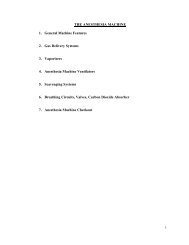BUMC Basics.pdf - Anesthesia Home
BUMC Basics.pdf - Anesthesia Home
BUMC Basics.pdf - Anesthesia Home
Create successful ePaper yourself
Turn your PDF publications into a flip-book with our unique Google optimized e-Paper software.
52<br />
• Vasopressin — pressor of choice if not able to maintain<br />
adequate blood pressure with blood product and fluid<br />
resuscitation.<br />
• NGT aspirate: If red blood then may indicate active GI<br />
bleeding. If coffee ground, than probably UGIB within 1 to<br />
2 days.<br />
**A negative NGT lavage does not rule out an UGIB.<br />
Large post-pyloric bleeds such as duodenal ulcers<br />
commonly have negative aspirates. It is usually okay<br />
to remove the NGT after the aspirate (unless you are<br />
going to use it for medications or something else).<br />
• Consult GI: Important things to tell them are<br />
1. Patient name and location<br />
2. Presentation<br />
3. Co morbidities and medications (including any<br />
NSAIDS)<br />
4. Actively bleeding or not (results of lavage)<br />
5. Significant labs: H&H, PT/INR<br />
6. Resuscitation efforts (how much blood/FFP has<br />
been given)<br />
7. Hemodynamics<br />
8. If a procedure is needed<br />
9. Remember the definition of urgent endoscopy is<br />
an endoscopy within 24 hours.<br />
• Follow serial H&H Q6 hours for 1-2 days, then change to<br />
Q 8-12 hrs<br />
• Make sure to repeat INR 1-2 hours after FFP<br />
• Vitamin K: Most cirrhotics who have significant jaundice<br />
are also Vitamin K deficient so give Vitamin K 10 mg SC<br />
daily x 3 days.<br />
• Keep NPO<br />
GENERAL HEPATOLOGY<br />
Acute liver failure<br />
▪ Basic definition: Jaundice, coagulopathy, and AMS<br />
▪ Very complex, sick ICU patients. Acute liver failure can<br />
progress very rapidly. Best managed on 4 west ICU (aka




